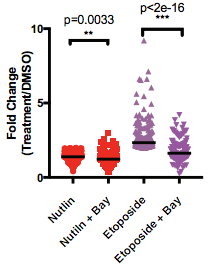Abstract
The tumor suppressor protein p53 is activated in response to diverse intrinsic and extrinsic cellular stresses and controls a broad cell-protective gene network. Whether p53:DNA binding and subsequent transcriptional activation differs downstream of these diverse intrinsic and extrinsic activators is controversial. Using primary human fibroblasts, we assessed the genome-wide profile of p53 binding, chromatin structure, and transcriptional dynamics after either genotoxic or nongenotoxic activation of p53. Activation of p53 by treatment with either etoposide or the smallmolecule MDM2 inhibitor nutlin 3A yields strikingly similar genome-wide binding of p53 and concomitant changes to local chromatin modifications and structure. DNA damage, but not p53 activation per se, leads to increased expression of genes in an inflammatory cytokine pathway. The NF-κB pathway inhibitor Bay 11-7082 abrogates etoposide-mediated activation of the inflammation gene signature but does not affect expression of canonical p53 target genes. Our data demonstrate that differential activation of p53 within the same cell type leads to highly similar genome-wide binding, chromatin dynamics, and gene expression dynamics and that DNA damage-mediated signaling through NF-κB likely controls the observed pro-inflammatory cytokine gene expression pattern.
